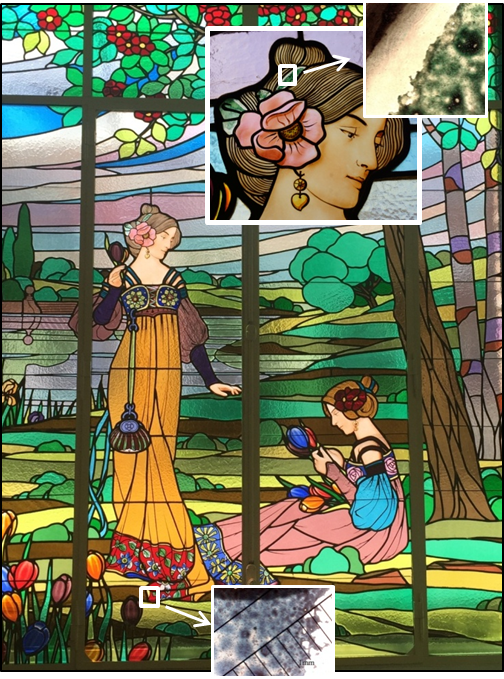Martí Beltran Gonzalez defends his thesis on the conservation of modernist stained glass
Jan 24, 2021
Martí Beltran defended his thesis directed by Dra. Trinitat Pradell on January 22 electronically. Titled “Analysis and degradation mechanisms of enamels, grisailles and silver Stains on modernist stained glass”, the thesis presents a study on the composition and degradation mechanisms of modernist enamels using analytical techniques
Materials and methods used in the production of modernist (late 19th and early 20th century) stained glass from the city of Barcelona with special regards to the degradation mechanisms of enamels, grisailles and silver stains have been studied. Coloured enamels from the raw materials used in the Rigalt, Granell & cia modernist workshops from Barcelona were produced and compared to those found in the buildings and belonging to the private collection of J.M. Bonet workshop to explore the reason for the reduced stability of the blue and green enamels.
The chemical composition has been determined (and pigments identified) by means of Laser Ablation Inductively-Coupled Plasma Mass Spectrometry (LA-ICP-MS), X-Ray Diffraction (XRD) and UV-Vis-NIR spectroscopy, and the thermal properties of the enamels measured by Differential Scanning Calorimetry (DSC) and Hot Stage Microscopy (HSM). The enamels are made of a lead-zinc borosilicate glass characterised by its low softening temperatures maintaining a good stability against chemical corrosion, in particular to water corrosion. However, the relatively narrow range of firing temperatures necessary for correct adherence of the enamels to the contemporary glass base may have required the addition of a high lead borosilicate flux, which would have increased the lead content of the enamel, decreasing the firing temperature but also its stability.
The historical enamels show a lead, boron and zinc depleted hydrated silica rich amorphous glass, with precipitated lead and calcium sulphates or carbonates, characteristic of extensive atmospheric corrosion. The blue and green enamels show a heterogeneous layered microstructure more prone to degradation which is augmented by a greater heating and thermal stress affectation produced by the enhanced Infrared absorbance of blue tetrahedral cobalt colour centres and copper ions dissolved in the glass and, in particular, of the cobalt spinel particles.

Share: